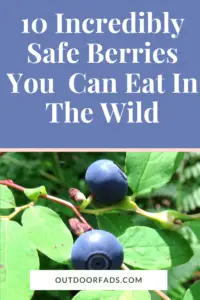We may receive commissions when you buy through the links on our site. Full Disclaimer.
You are probably preparing for your next camping or hiking trip, or you are up the hills already and need information on the best ways to stay alive, So you have seen some clusters of berries during your trips and wondered if they are safe to eat or you need forehand information on the ones you will come across in the long run. Well, you are in the right place because we have brought you a list of the safe berries to eat in the wild when next you are out.
The Awesomeness of Berries isn’t news, apart from being succulent(pop with no seeds) and tasty they are also multifaceted fruits that can take various appearances, they could be tarts, jam, or jelly. Berries can grow in different climates, so there is a berry for every climate, they are also beneficial to the body system.
Here is the deal, lots of berries are great for the body, but some can kill or cause great pain to the body with just a bite or touch. It is better to stay alive than getting killed by some fruit due to lack of information, and this is why we have brought you a list of edible berries today so you would know the next time you see one.
ALSO READ: How to Identify Poison Berries & 10 Poisonous Wild Berries to Avoid
10 Wild Berries You Can Eat
1. Huckleberries
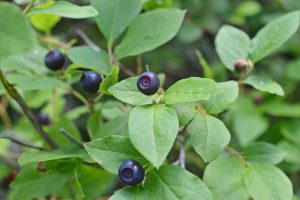
Huckleberries are a part of the Gaylussacia species of the Ericaceae family which makes it a kindred to blueberry due to their similar small, round and bluish look one might think they are the same but huckleberries come in other colors. You will identify huckleberry by:
- Its shallow roots are growing from an underground patch.
- Its young stem leaves are most times hairy.
- Their colors which could be blue, bright red or darkish purple
- The taste, when eaten, is sour or tart.
- Their many tiny seeds.
According to experts, Huckleberries are excellent for the body, and they are one of the most significant carriers of antioxidants that helps improve the body’s blood sugar and insulin level.
2. Cloudberries
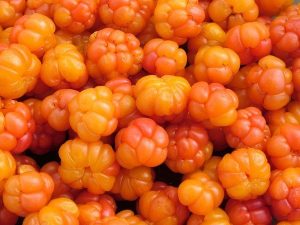
Cloudberries are distinct in color. Their amber-yellow color is why it’s called the “gold of the artic.” In shape, they look similar to raspberry because of the small clustered balls which form as one. You identify cloudberries with;
- Creepy and shrub-like roots, they grow in bushes.
- Their habitat is damp fields with low acidity and direct sunlight.
- Being around mosses or mashes.
- Fruits that are yellow when ripe, red-yellow when unripe.
- Its sweet and juicy taste.
With a Vitamin C level that is four times as equal to that of an orange, cloudberries provide adequate nutrients.
3. Gooseberries
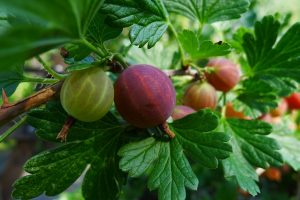
Gooseberries almost look like currants but for their green color when unripe and red purplish when ripe, they also come in other colors like red or white. If you happen to see this berry, you can harvest both the ripe and unripe ones; ripe is best for eating directly while the unripe ones work best as jams and jellies because they contain pectin(source-careomnia.com). If you see something that looks like gooseberries and you need to confirm, here are things you can check:
- Branches that are thick and spiny.
- They are green when ripe, red-purplish when ripe.
- They have bell-shaped flowers that grow in 4-5 clusters.
These berries could be sour or sweet, and they have a large component of water in them, which is great when hiking. And according to Elise Mandl, gooseberries are great for your brain, body sugar, and weight.
4. Buffaloberries
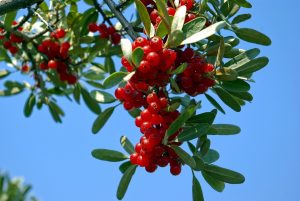
Buffaloberries are also known as Bullberry or Shepherdia. It has two variants which are shepherdis Argentina or Canadensis. They both have similar fruits. Distinguish Buffaloberries through:
- Dark red color with little white dots on them.
- Their composition in large shrubs or small trees.
- Growing in dry locations.
- Their long spiny stems with thorns about 3cm high.
- Half Green and Half Silver leaves that go brown in May/June.
- They grow in clusters, one pluck rewards about 10 and more berries.
They are sour in summer and get tastier in the colder seasons, these berries are rich in vitamin C and antioxidants. But be careful not to take them in large quantities; otherwise, you get digestive irritation.
5. Salmonberries
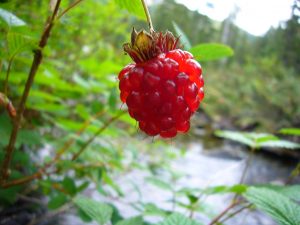
Salmonberries are known for their decorative flowers, their yellow color similarity with cloudberry, and matching form with raspberry. You would be able to know salmonberries through:
- Location at moist and wetlands.
- Erect and arching woody stems with prickles on them.
- Single leaf growing in three folds. The middle leaflet longer than the two at the sides.
- Pinkish-Purple flowers with five petals, they bloom around March to June.
- Globose-shaped Fruits similar to the raspberry.
- Ripe fruits turn deep red when ripe.
Salmonberries are sometimes said to be flavorless. It has a high moisture content, which makes it a great source of water when eaten. It also has high vitamin content.
6. Elderberries
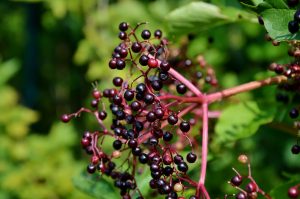
Elderberries are known to be very medicinal plants, and they are also best eaten when it’s cooked while harvesting them be careful with the leaves and barks which are poisonous. Identify one by:
- Its location in wet and swampy areas.
- Its shrub or tree-like structure which goes about 6ft in length and weight.
- Juicy flesh that surrounds the central pit revealed when the berry is split.
- Their ivory-white colored flowers.
- Blue-black fruits that grow in drooping clusters.
Their flowers have sweet fragrances. Elderberries have low calories, high in vitamin c, and dietary fiber that aids digestion (Healthline).
7. Chokeberry
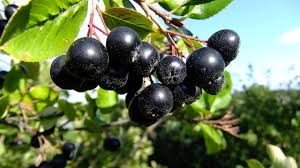
Chokeberry, also known as Aronia berry got its name because of the sharp mouth-drying sensation the berries give when eaten. They can be eaten raw but taste better when processed. They are either purple or black and are known for their:
- Shrub or tree-like structure that can get to 4ft tall in width and length.
- Leaves are glossy and dark green.
- Flowers are vibrant white with five petals.
- Fruits are in bunches.
- Pea-sized Fruits.
Chokeberries can be eaten raw or added to oatmeal and yogurts for breakfast. According to Health Benefits Times, these berries are known to help with weight loss, eye and, skin improvement, and help prevent viruses.
8. Mulberries

Mulberries are fruits of very tall trees. They look similar to blackberries but are quite different. They produce a delightful and vanilla-like taste when ripe. It is better to avoid eating its unripe fruits because it is said to carry some toxic substances. Mulberries are best identified with:
- Tall trees that go about 30-50ft tall.
- The leaves grow side by side and in simple forms.
- multiple fruits which rest on a dangling fig of about 2-3cm long.
- Unripe mulberries are green, white, or pale yellow. The fruit goes pink or red when ripening then goes dark purple when ripe.
Mulberries come in various species; white, red, and black. They are known for their very strong flavor, and they have Vitamin C and Iron in their Nutritional composition.
9. Saskatoon Berries
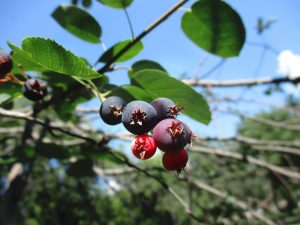
Saskatoon Berries grow from shrubs and very tall trees, and they are small dark-purplish fruits that look similar to blueberries. They are known to ripen even after plucking, which makes it easier to freeze till consumption. They have a sweet, almondy taste. Theses berries are easily identified by:
- Their growth in well-drained and loamy soil.
- Trees growing to about 3-26 ft in height.
- Roots growing in colonies.
- Their white flowers with five separate petals.
They have been said to help people with Parkinson’s disease, provide the daily requirement of calcium, and high in iron (As written by Deana Steele).
10. Muscadines
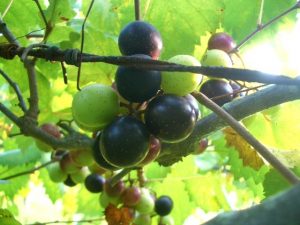
Muscadines are grapes since it is a variety of grapevine plants. They might not be a favorite for eating due to their thick skin, but these berries make wines, jellies, and, juices. So, if you see a plant with:
- Tall trees with spiny branches,
- Location at warm and humid areas,
- Fruits growing in bunches with at least five in one pluck,
- Hard skin fruits which are green when unripe then bronze, black or red when ripe,
It is most likely muscadine. You might not enjoy eating this but be sure to try some of it in wines or jellies. Organic facts say they are great for cardiovascular, digestion, and body mass care.
Conclusion
You should have gotten more knowledgeable on the berries that are safe enough to eat in the wild. With this article, you should know(or be able to refer back) and be able to recognize some wild berries that are safe to eat.
It is vital to know the things you put in your mouth including their capacities and components, this is why we’ve compiled this list but remember to take caution in putting unknown berries in your mouth if you get confused, you could try a trick from Matt of gardeners path, rub it on your skin to check for irritation, then on your lips to see if it burns, It isn’t advisable in a situation where you are stuck between two plants though, just let it be and move on because some toxins take time to react. Stay Safe.
